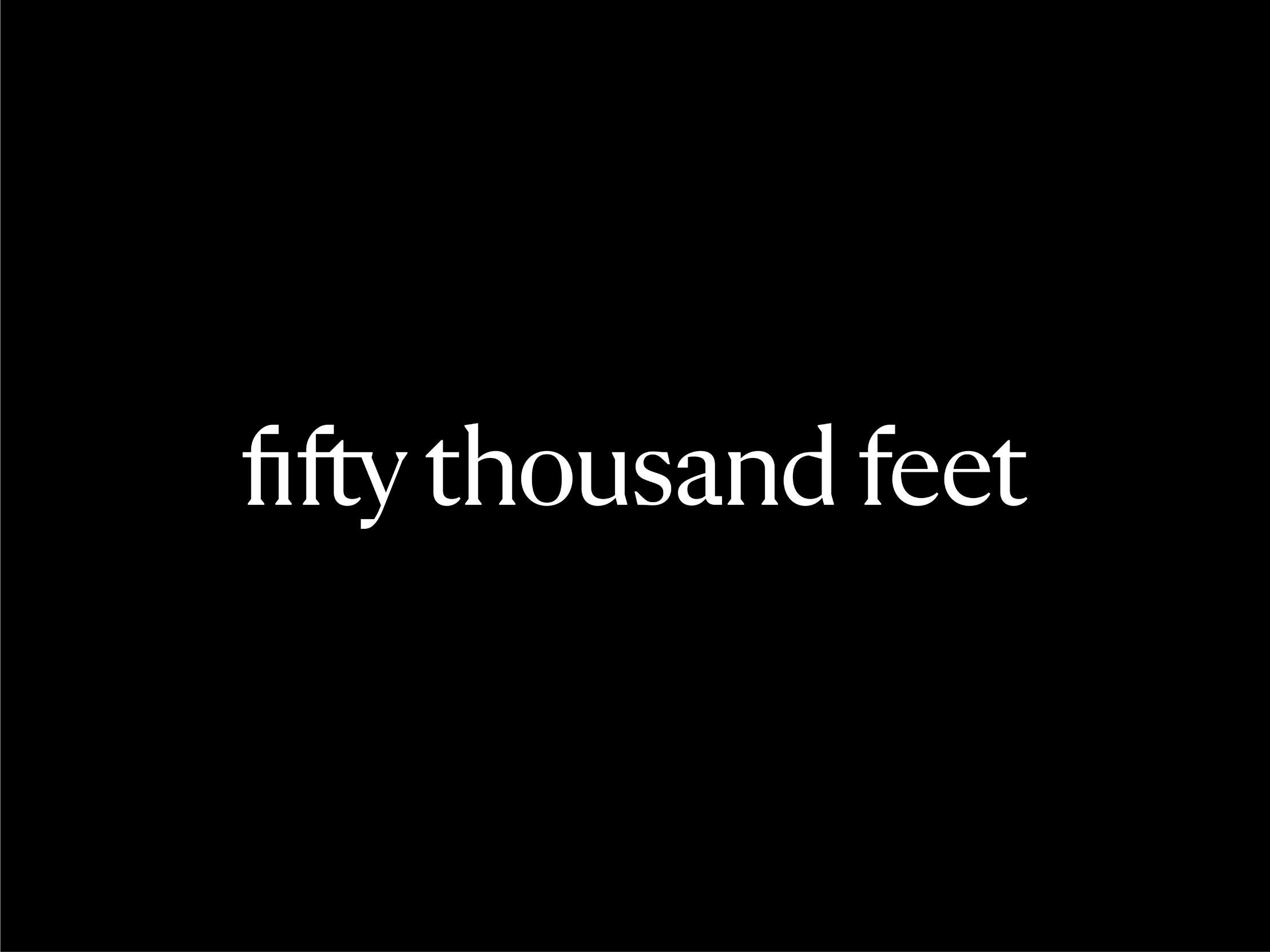
Building an AI-native agency
June 13, 2025 / 6 min read

Every business today is wrestling with the same question: How do you embed AI into your organization in a way that supports your goals? At Fifty Thousand Feet, our answer is to become an AI-native company focused on building timeless brands.
We have always believed that timeless brands don’t just endure by chance. They’re conceived, grown and guided intentionally. Their strength lies in growing with purpose, not chasing every new wave. That’s why we are integrating AI as an intrinsic capability, not as an overlay. We’re not positioning ourselves as an “AI-first” agency. We’re choosing to be AI-native, and that is an important distinction.
Where AI-first approaches begin with technology and look for problems to solve, we begin with the brand—its core identity, values, and strategic positioning. Our aim isn’t to bend creativity around automation. It’s to create and curate tools that elevate imagination, insight, and consistency in ways that stay true to a brand’s essence.
To become AI-native, we are evolving across three interconnected pillars—culture, process, and products—that are reshaping how we work and what we offer.
Culture: Empowering Our People
We started this work internally in 2023, just as generative AI was gaining traction. We created an AI task force, invested in team training, and surveyed our teams to assess how they were using AI. We have since given team members access to l AI platforms and invited them to test, explore, and develop their own use cases. We continue to foster dialogue through surveys and meetings where everyone can share insights and analysis about our evolving AI practice. The goal is to cultivate a mindset of curiosity and creative experimentation—anchored in the belief that AI can extend our capabilities, not replace them.
That cultural investment is already reshaping how we think and work.
From crafters to conductors: Our people are evolving from being exclusively solo makers to becoming more like orchestrators of creative systems. Instead of manually building each asset from scratch, they define creative direction, provide human-crafted inputs, and refine outputs generated with AI assistance.
From linear to iterative thinkers: We no longer follow a single sequential path. We are embracing rapid prototyping, using AI to explore multiple ideas in parallel, gather fast feedback, and adjust in real time.
From specialists to system thinkers: Rather than focusing narrowly on one channel or format, our teams are designing scalable frameworks and modular content systems that AI can help adapt to diverse contexts, from brand messaging to UX design to campaign execution.
This mindset shift isn’t about doing less. It’s about thinking bigger and more dynamically.
Process: Making Every Phase Work Smarter
As we evolve culturally, we are also reengineering how we work. Our delivery lifecycle is becoming AI-native, from the earliest client conversations through execution to governance.
Some of the most meaningful process changes include:
Discovery and planning: Strategists are now using AI to synthesize insights from stakeholder interviews, analyze tone in client documents, and map naming territories and industry trends in minutes rather than days. Our briefing forms can pull contextual data from the web and CRMs, giving account managers a smarter starting point.
Strategy development: AI now helps us identify whitespace opportunities and simulate customer journeys. We are using it to generate workshop prompts, explore positioning directions, and synthesize insight patterns across verticals—accelerating the development of distinctive, actionable brand strategies.
Creative expression: Designers are using AI to build wireframes, explore type pairings, and generate visual concept options aligned with brand inputs. Writers use AI to test tone-of-voice calibrations, generate first drafts of messaging frameworks, and extend storylines across platforms with brand-safe adaptations.
Governance and delivery: We are developing tools that automate brand consistency checks and detect off-brand content before it goes live. AI helps us audit adherence to brand standards and spot issues early—helping clients stay consistent at scale.
Team operations: Our producers and account leads are beginning to use AI to generate statements of work and timelines based on past project data, monitor documentation against scope and deliverables, and create asset readiness trackers automatically.
These changes aren’t only about speed. They’re about better quality control, earlier insight, and freeing our teams to invest more energy in higher-order thinking.
Products: BuildingTools That Scale the Right Way
The third pillar is where our investment in AI meets our client offering. We are building client-facing tools that embody our core belief: AI should serve business needs—not be the starting point for solving them.
Our first product in development is a conversational brand management platform that applies AI to a problem every brand (especially large, distributed ones) struggles with: getting the right brand assets, guidance, and approvals into the hands of the people who need them, when they need them, without overwhelming brand teams. Traditional digital asset management systems aim to solve this problem, but too often they are difficult to navigate, poorly adopted, and fail to support real-time decision-making.
Our solution will use AI to make brand guidance more accessible, intuitive, and responsive. Instead of forcing users to hunt through static repositories, the platform will allow them to ask natural-language questions like, “What assets do I need for a client event?” and get tailored, on-brand recommendations instantly—whether it’s voice and tone guidance, visual templates, or copy suggestions.
The system will also offer real-time feedback on creative work. If someone’s drafting a social post or internal presentation, they can ask, “Does this align with our brand?” and receive immediate input. This will help teams stay consistent without waiting on brand managers or risking off-brand decisions made under deadline pressure.
We are currently prototyping the MVP, with pilot clients planned in the coming weeks. Ultimately, we are building a scalable, self-service solution that protects brand integrity while reducing friction, and that applies AI where it actually matters: helping people do better work, faster, with greater confidence.
AI Aligns with Brand Strategy
At every stage, our guiding belief is clear: AI should strengthen a brand’s identity, not overwrite it. The creative decisions, emotional insights, and strategic clarity that give brands their distinctiveness can’t be automated. They need human hands and human judgment.
We don’t think AI should be the story. We think it should help us tell better ones.
That’s why we’re integrating AI in ways that support deeper brand relevance, more thoughtful expression, and more cohesive systems, all without compromising the qualities that make a brand matter in the first place.
This Is How Timeless Brands Stay Timeless
Timeless brands anchor meaning in the moments that count. They adapt to change without losing their center. They innovate within a framework that stays true to who they are. That’s what being AI-native allows us to do: make the work more agile, without making it generic.
At Fifty Thousand Feet, we are building a smarter operating system for ourselves, our clients, and the enduring brands we help bring to life. The work we’re doing isn’t a departure from our core. It’s an evolution rooted in the same principles: strategic depth, exceptional design, and systems that hold up through time.
Categories
- Work




